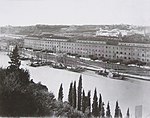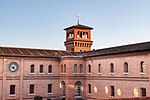Pons Sublicius
Bridges in RomeRoman bridges in ItalyRome R. XIII TrastevereRome R. XII Ripa
The Pons Sublicius is the earliest known bridge of ancient Rome, spanning the Tiber River near the Forum Boarium ("cattle forum") downstream from the Tiber Island, near the foot of the Aventine Hill. According to tradition, its construction was ordered by Ancus Marcius around 642 BC, but this date is approximate because there is no ancient record of its construction. Marcius wished to connect the newly fortified Janiculum Hill on the Etruscan side to the rest of Rome, augmenting the ferry that was there. The bridge was part of public works projects that included building a port at Ostia, at the time the location of worked salt deposits.
Excerpt from the Wikipedia article Pons Sublicius (License: CC BY-SA 3.0, Authors).Pons Sublicius
Pista ciclabile del Tevere, Rome Municipio Roma I
Geographical coordinates (GPS) Address Nearby Places Show on map
Geographical coordinates (GPS)
| Latitude | Longitude |
|---|---|
| N 41.884444444444 ° | E 12.476666666667 ° |
Address
Pista ciclabile del Tevere
Pista ciclabile del Tevere
00153 Rome, Municipio Roma I
Lazio, Italy
Open on Google Maps










